Facebook Ads Audit: Learn how to diagnose your account
Posted on 12/11/2023
Reviewed by Arnt Eriksen updated at 12/24/2023
Introduction
Performing a Facebook Ads audit is no child's play!
But as exhausting as it can be, it is the best way to ensure that your Facebook advertising strategies are paying off. Running Facebook ad campaigns ought to be an investment in your business. But to make sure this investment is paying off the best it can, it is important to do regular thorough diagnostics.
The major aim of the audit is to discover ways to improve your ad performance while identifying the parts that work properly.
A good audit will take you from what you think is working to what is actually working. This information helps you to conveniently manage and maximize your paid strategies on social media.
Facebook ads audit requires all time and thoroughness. You won't achieve much if you only scratch the surface. Instead, it is best to break the audit process into key sectors that allow you to reach the fundamentals and organize things all the way up.
In this article, we'll be exploring the processes of an in-depth Facebook Ads audit.
What is A Facebook Ads Audit
In the simplest terms, Facebook Ads audit refers to an in-depth analysis of everything that goes on with your Facebook ad campaigns. This form of Facebook audit is most effective when it is broad, covering every area of your Facebook advertising, and also deep, reaching every detail.
You can run your Facebook account audit every week, but if you are not able to meet up with the frequency, then you should ensure that you run a Facebook ads audit in these four circumstances.
- At least once a month, to be sure that everything is running smoothly.
- When you take on the management of a new client's Facebook Ads account.
- When a particular ad campaign is not performing as expected and you need to find out why
- When you need to test a new campaign strategy or you plan to modify existing campaigns to optimize their results.
This kind of auditing evaluates all the metrics that make up your ad campaigns. It also reviews your target audience, your tools, and your strategies. With such account overview, you can find trends and patterns in your performance and come up with solid strategies for better performance.
How To Perform A Facebook Ads Audit
Step 1: Gain unrestricted access to the Facebook Ad Account
The first step to a Facebook ads audit is to access the Facebook Ads account you plan to audit.
It is possible to conduct an audit with Facebook ads analytics alone. However, you will get more results when you gain access to the analytics directly.
There are instances when you need more data than what the typical analytics report presents. For instance, CTR and frequency metrics are not automatically added to the reports from the dashboard. You have to manually add them to the dashboard but you can only do this by accessing the Facebook ad account.
Accessing the Facebook Ads account allows you to view the campaigns from a broader perspective than the reports provide. With more information, your audit is way more thorough since you can track how ad performances have evolved over time, not just the current ads campaign you are running.
If you plan to audit an account that you do not have access to, you can copy a code provided by Facebook and send it to the client to grant you access to their Business Manager. Alternatively, you can send this link to your client so they can follow the instructions to grant you access.
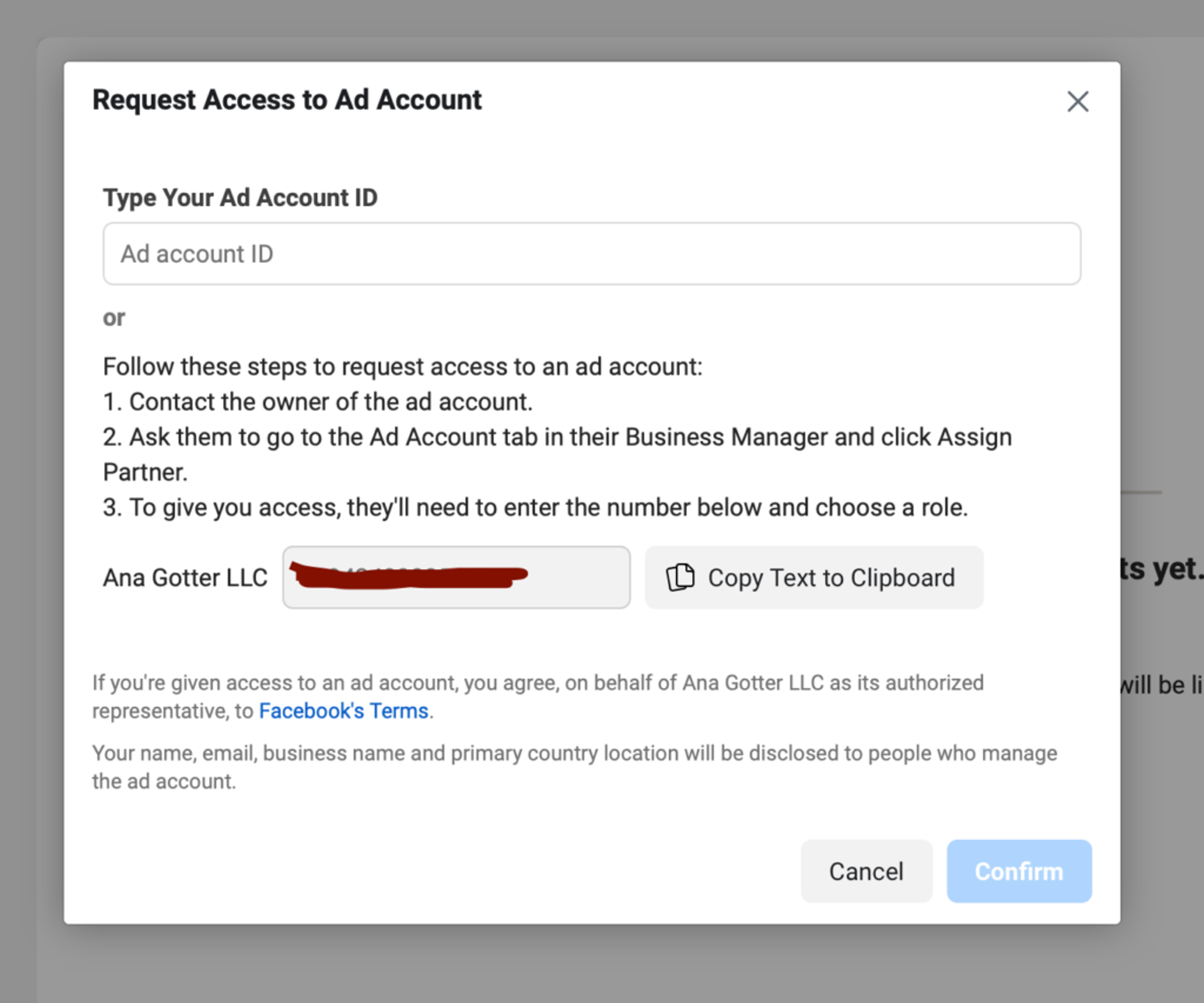
If you are granting access to an expert to audit your Facebook ads account, this is a good time to audit access permissions to your account. Businesses that employ social media managers often can't keep up with who has resigned and whether or not they have been disconnected from the business platforms. Check all those who have access to your Facebook ads account and remove anyone who has no business having access there.
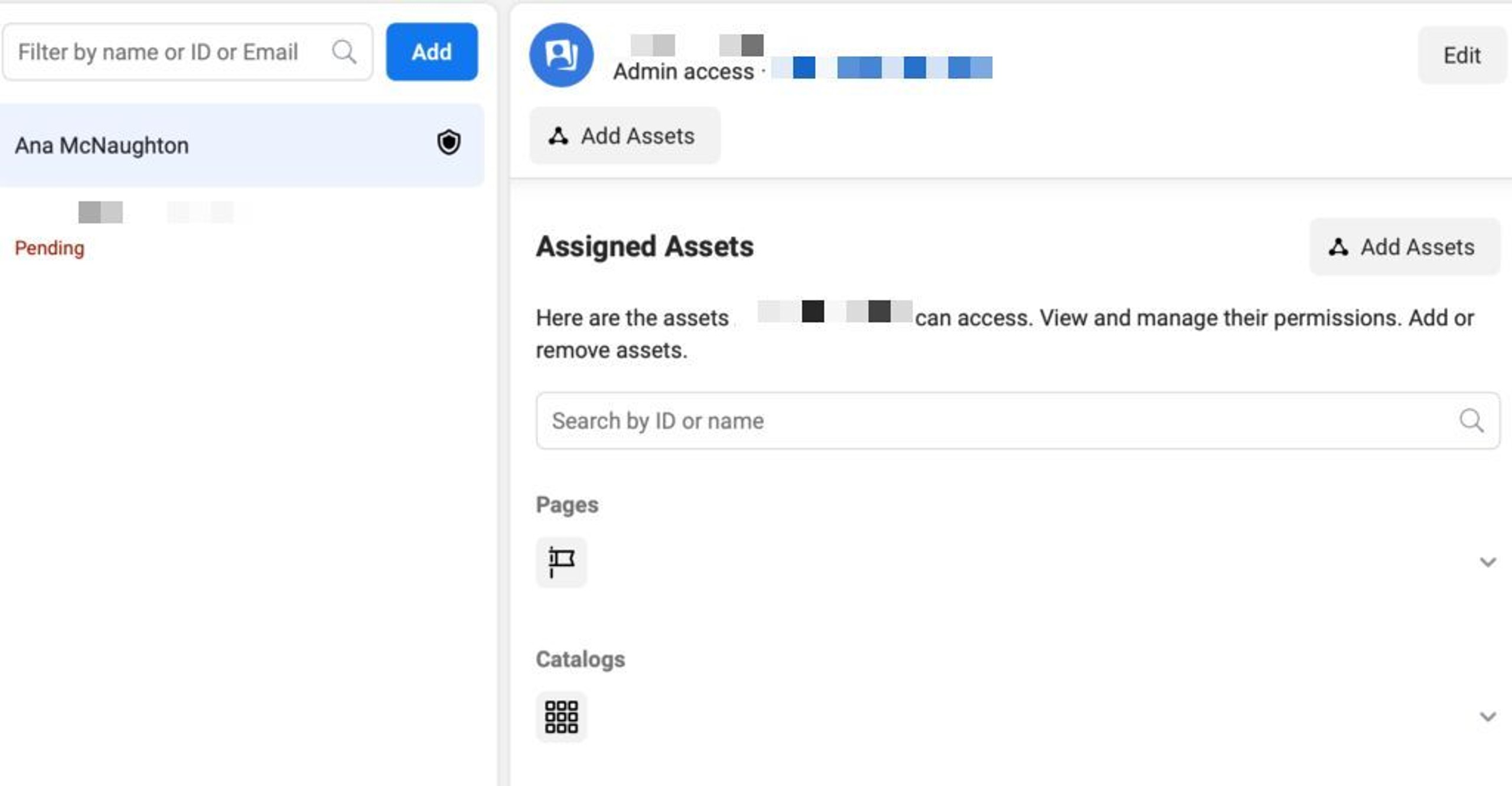
Step 2: Review The Metrics And Download the Reports
Now that you are in, go to the Facebook ads manager and look through the data. You can also explore third-party tools that report and analyze ad performance.
The Ads manager gives you access to every available data on the ad campaigns that are currently running on that account. You can modify the current analytics dashboard by adding other fields of metrics that are important to your audit. To do this, click on "Report" and then "Create Custom Report"
Find an example in the picture below.
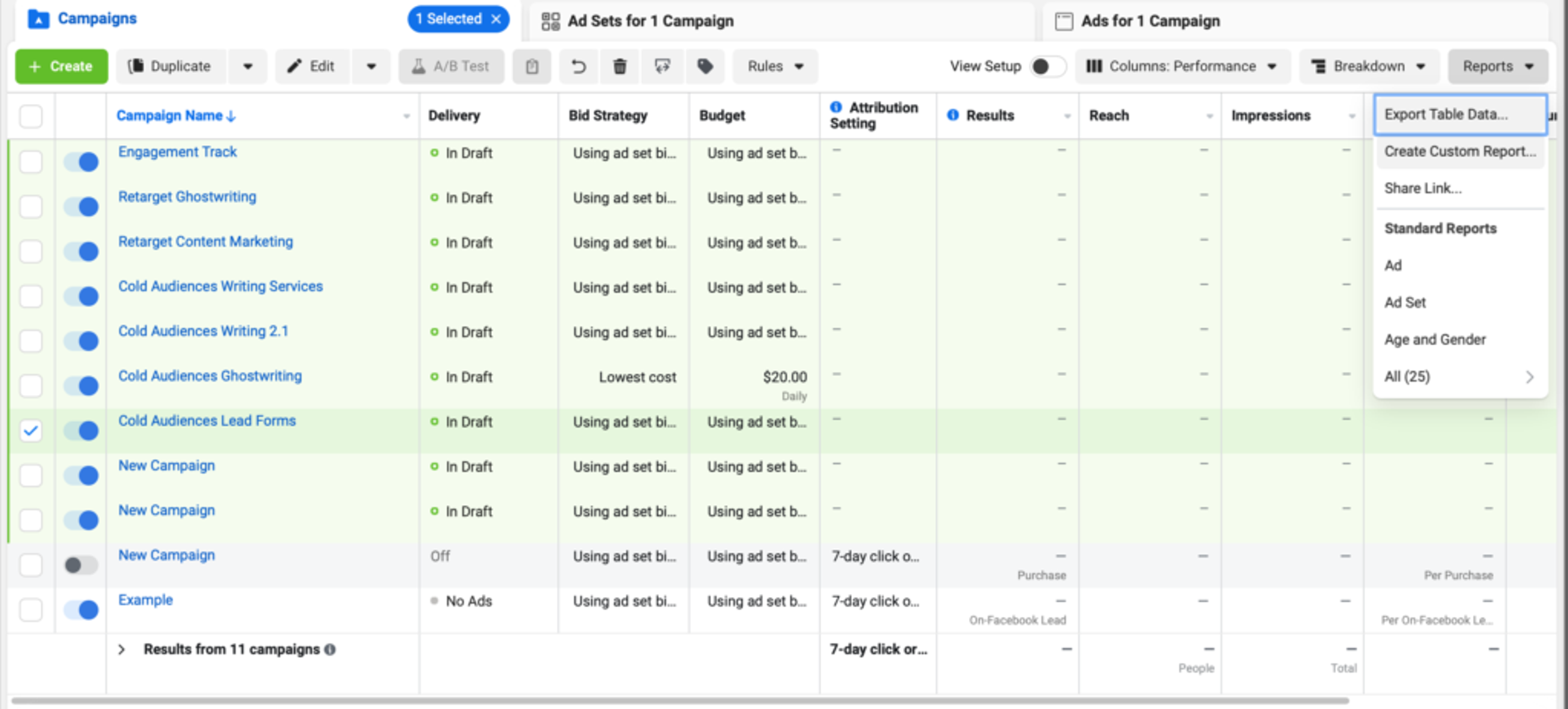
You can get reports on the ad campaign, ad set, or ad level, depending on how specific you would like to be. If you are trying to evaluate the ad creative based on visuals, creative direction, offers, and messaging, you have to start auditing from the ground level, which is the ad level. You can then download your report as an Excel or CSV file.
When generating your Facebook ad report, ensure that you have information on important metrics including:

- Click-through rates;
- Cost per action;
- Ad Spend;
- Reach;
- Quality ranking— this refers to the quality of your ad as perceived by the same audience your rivals are targeting;
- Engagement rate ranking—this refers to how well the audience is expected to engage with your ads compared to other ads that are in competition for the same audience;
- Conversion rate ranking—this shows how well your ads are expected to convert compared to other ads that are in competition for the same audience and have the same ad objective;
- Rate of actions by viewers;
- Clicks.
You can download these infographics from the page, which will help you communicate the reports to clients or colleagues in clearer terms.
Step 3: Work With a Report Document
When you carry out a Facebook audit, the reports can be vast and overwhelming. This is why you have to know what you are looking for before searching through the reports. Before you open that dashboard, ask yourself, "What do I want to know about these Facebook ad campaigns and why?"
Once you figure this out, prepare a document where you can pen down your observations and findings as you see them. Once this is in place, the report you download will only help you answer the questions you have asked. You know what you are looking for, so it is easy for you to go after it in the report and fill it into your document.
Typically, Excel sheets are often used for evaluation documents like this, after which the review is summarised into a Word document or a Notion file.
This strategy works best for people who know what they are trying to track. But what if you know there's a problem, but you don't know where to start?
In the next step, I'll share a few templates for auditing.
Step 4: Assess the Performance of Campaigns and Audiences
If you have no idea where to begin, start by observing. Check through your ads and campaigns, then draw similarities, patterns, and trends among the ones that performed well. You can also do this for those that underperformed and compare them to those that did not in order to determine which strategy has been effective and which one was not.
If you are working with a small account, you can go through each Facebook ad to evaluate. But if the number of your ads and campaigns is in the hundreds, you can use your highest-performing ads or campaigns as case studies.
Even at this point, you can segment your evaluation based on the campaign objectives, target audiences, and the stage of the funnel the Facebook ad is targeting.
Break this down by objective, audience, and stage of the funnel you’re targeting.
Then begin to look at the following trends:
Is the target audience high-value?
Do they convert frequently?
When you succeeded in driving clicks or the desired actions from the audience, which ads performed best?
When you answer these questions, move on to ask "Why?"
Check for patterns in the following Metrics
Ad Quality

This is about storytelling, ad copy, use of words and color in your carousel ads, video ads, image ads, or messaging ads.
Now let's dive deep into Ad creatives.
Many businesses set up the same ad creatives in various dimensions, but do they pay attention to the different performances of those versions? The ability to express your value proposition through excellent visuals and ad copy is a skill that is learned with consistency.
As you evaluate the quality of the ad, these are questions you want to ask yourself.
- Do the text and headline clearly communicate the message of the ad?
- Is the headline unique to the ad creative or was it generated from the landing page?
- Does the copy align with the idea of the creative?
- What ad formats are most suitable for this kind of campaign, and this level of the sales funnel?
- Does the ad creative have too much text on it?
The ultimate question in assessing the value of an ad is this: can you understand the value proposition in three seconds? If the answer is no, and you have to read the copy more than once to get the message, the ad may not perform as well as it should.
Ad Budgets
Did the campaigns that have higher costs per action bring in more profits solely because of their budgets?
What stage of the funnel do you reach most effectively?
At what stage of the funnel does your audience bounce off?
Questions like this help you detect gaps in your campaign. For instance, when you get a lot of clicks and no conversions, there might be a problem with your landing page. It might also be due to the wrong audience targeting.
You can take it a notch beyond the ads and look through the entire conversion process. From the Facebook ad to the landing page, the product page, and the process for checkout. When you have conversion issues, the major cause is likely hidden somewhere between these processes. You should check through the process both on mobile and desktop.
Now let's talk a bit more about audience and ad placements.
The whole idea of advertising on Facebook is to communicate the value you are offering to certain people. The more specifically defined this audience is, the more effective your campaign will be in reaching them. While you carry out your audit, you should also have a clear picture of what your ideal audience should look like. It should be clearly defined in terms of age bracket, income bracket, gender, interests, and location.
This is the benchmark against which you evaluate your target audience as you conduct your audit. Meanwhile, these details of the target audience should be provided by your client so that you can spot any differences between your client's ideal audience and what the ads have actually been targeting.
Another detail to look at is where your ads show up. As you evaluate the ad placements, you need to keep two factors in mind:
- The ideal audience;
- The campaign objective.
Now, look through the ad placements that each campaign has worked with over time. Looking at how they work with the ideal audience and ad objectives, you can decide to move the campaigns around various ad placements or take out some of them to maximize the budget.
For instance, if you're offering a workplace solution and your ideal customer is a corporate worker, chances are that they keep work limited to their desktop. They would find your solution more relevant when they use Facebook on their desktop, rather than it popping up on their mobile phones while they're searching for an old friend.
With this picture in mind, the first strategy would be focusing your budget on desktop ad placements rather than mobile.
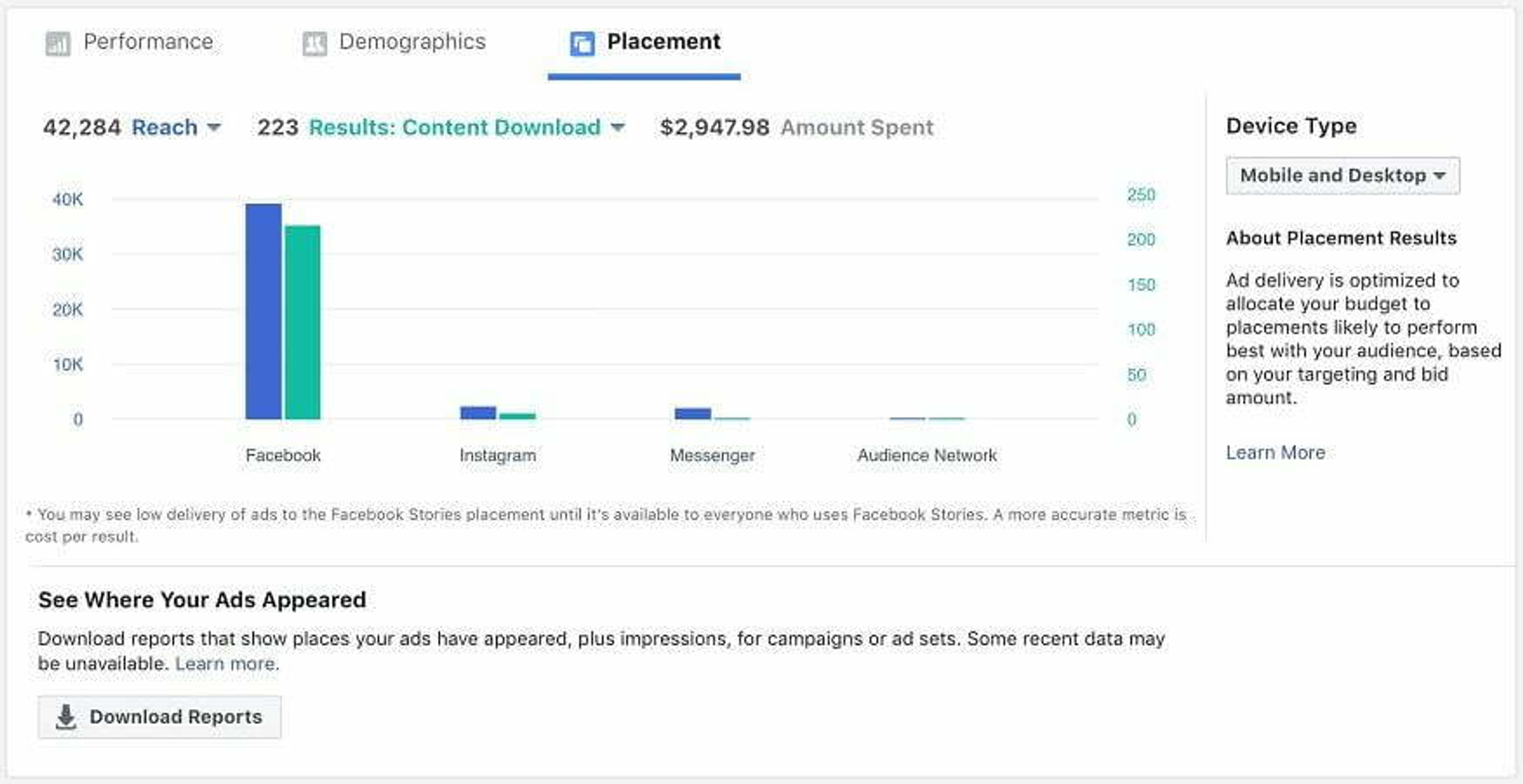
As you make recommendations to narrow down, I should sound a note of caution here. The delivery of each Facebook campaign is mostly limited by the size of the audience you target in each Facebook campaign. A very narrow target audience can harm the overall performance of your campaign.
Therefore, you have to use only the most important filters so you can keep your audience aligned with your target market, yet broad enough for Facebook's performance optimization
Facebook allows you to measure the size of your audience using two different indicators.
Audience definition
This indicator works like a dial that shows you how broad or narrow your audience is within an ad set. As you add filters to narrow down, make sure you pay attention to this dial to see if the audience size is within Facebook's capacity for audience optimization.
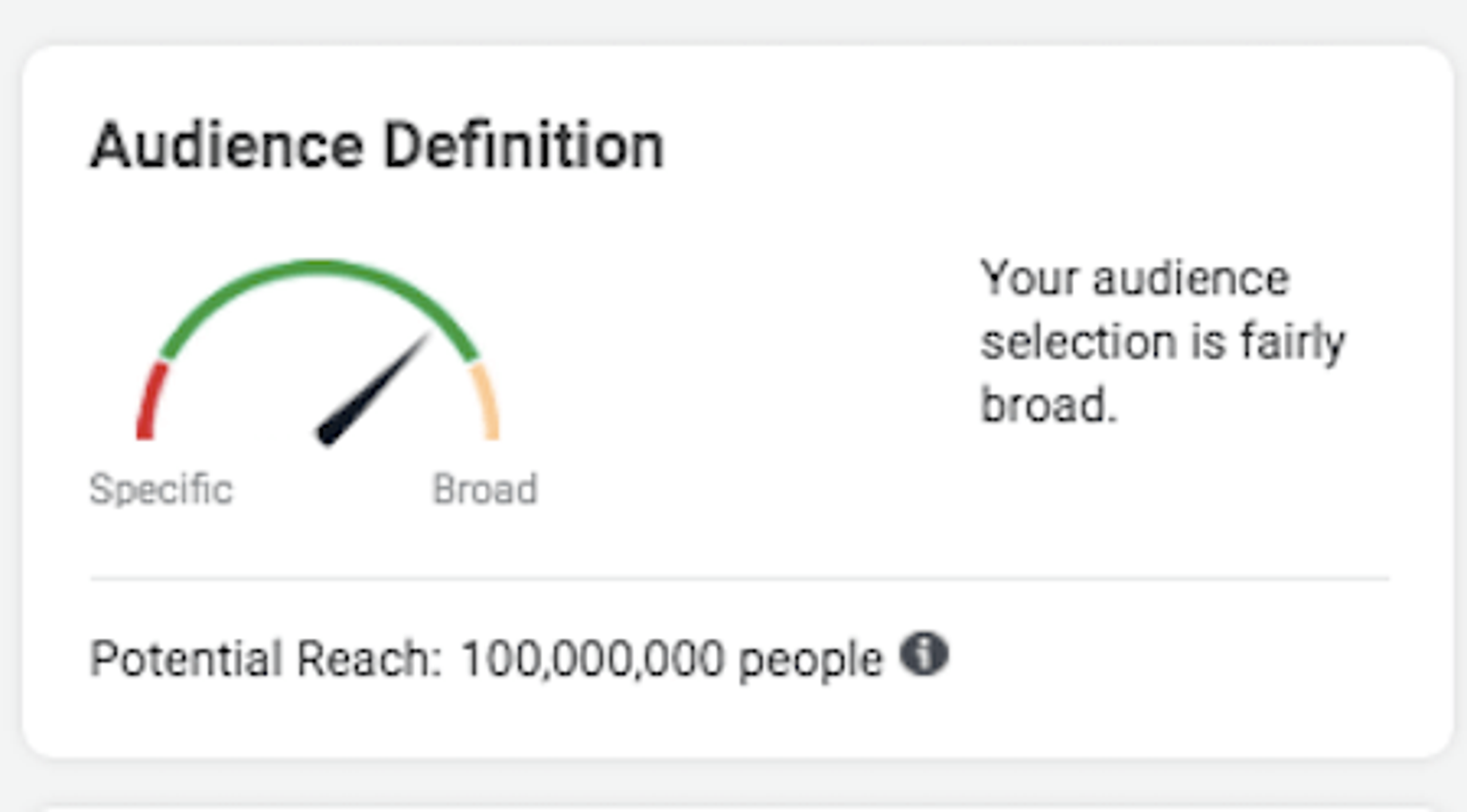
Considering the iOS 14.5 updates, an ideal audience size shouldn't be any less than 500K users.
Delivery
The other indicator appears as a delivery column. This column is located on the Ad Set tab of the reporting dashboard. The delivery column automatically updates according to the progress of the campaign. If the indicator displays “Learning Limited,” you need to increase the audience or the budget. To expand the audience size, you can combine similar audiences.
Compare custom audiences vs. lookalike audiences
You’ll want to analyze how many variations of audiences there are within the Facebook ads account, as well as what types of audiences are included. In this category, you want to check your ad structure and how your ad sets have been matched with the audiences
Check out each audience present within the ads account.
Does it have custom audiences?
Does it have buyer personas (an audience category that you have created based on interests, age, gender, or any other filter you have put in place?)
Does it have lookalike audiences?
How are the ad sets organized, do they target both lookalike audiences and buyer personas?
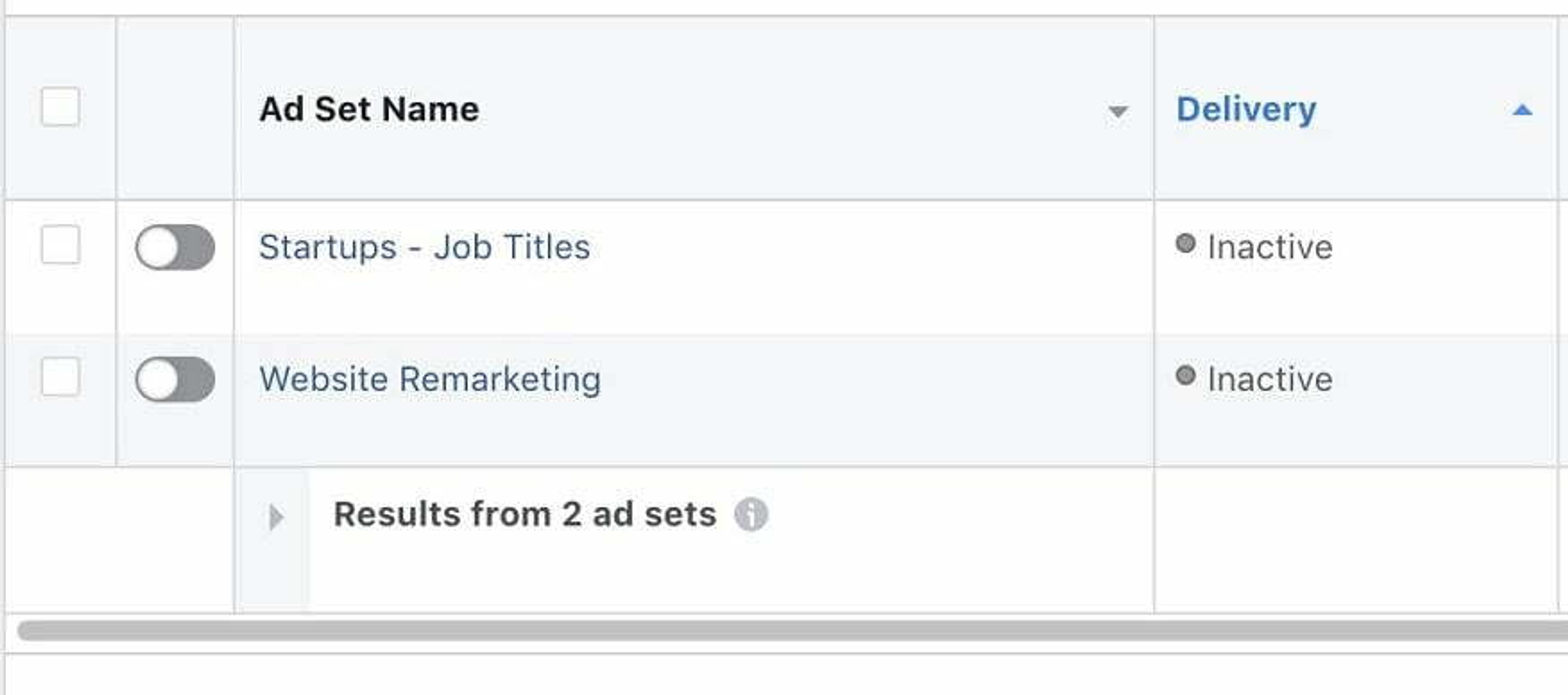
If you find any ads that target custom audiences, lookalike audiences, and buyer personas, you should flag them
It is important to categorize the audience clearly and create an ad set according to each category. This is the only way you can make the most of your ads and measure the progress of your audience through the sales funnel.
When you open the Ads manager, go to the Audience section to view all the audiences your client has created so far;
Make sure to note if they are named clearly. If not, suggest options for naming audiences as clearly as possible. For instance, when you use names like “PROSPECTING_TOPFUNNEL_JANUARY 2023” you can immediately see what creative you are meant to use with this audience.
In your report, you should stress the need to update the custom audience frequently. This is because more people engage your Facebook page, visit your website, subscribe to your mailing lists, and make purchases over time.
Typically, the frequency of audience updates varies based on the size of the business and the industry it operates in. In general, you can update your custom audience between monthly and quarterly intervals. You can do this by updating a new list manually, or generating your automated feed. Facebook Pixel or another third-party tool can come in handy.
Not only does an updated custom audience improve the quality of your data, but it also improves the quality of the lookalike audience you generate from it.
You can create multiple lookalike audiences using different ad sets to see how one performs better. This will help you determine what strategies are working and which are not.
You also want to observe the exclusion patterns in the audience settings. When creating a lookalike audience or an audience persona, does it exclude custom audiences and converted customers?
If the answer is no, then you should pen this down as an observation.
As you make your observations, do not forget your evaluation notes. Make sure to note down ad campaigns or ad sets that should be flagged and what should be done about them.
Step 5: Review All the Ad Tools You’re Using
Ad creatives, target audience, and the sales funnel all remain important parts of your strategies while running Facebook ad campaigns. However, the tools you use are as important as the campaigns you run.
This is why you have to go through every tool to ensure that they are functioning effectively.
Now let's start with your Facebook Pixel.
You have to check to see that your Facebook pixel is properly installed. You also have to ensure that they are tracking the right events.
Now go to your custom audiences. Does the custom audience database cover every audience you would like to retarget?
Check the custom audiences on your retargeting lists if they are due for restructuring. For those who you plan to retarget, some of them have made a purchase over time. You have to take them out of that list and add them to the custom audiences that you are trying to retain. If you don't do this, you may continue to show your custom audiences products that they have already purchased. Not only will you not retain them, but you'll be wasting your ad budget on people that do not fall within the retargeting category.
After this, go to your product catalogs. Are they updated? You have to make sure that you upload images of new products and take down images of those that have run out of stock.
If you use a lead magnet to get people to your product catalog, evaluate your lead forms to be sure they ask the right questions, just enough to give you relevant information without boring them away. When your audience signs up for a lead magnet, how quickly do they get it?
Then look through your ad structure.
How are your campaigns organized?
How easy is it to locate your campaigns based on name search?
What attribution systems do you prefer and why?
Keep your evaluation document close and note everything that needs to be changed or modified.
Step 6. Compile the Information into a Report
By now, you should have more than enough information about the Facebook ad account and all the changes that need to be implemented.
Put all your observations and comments together and organize them into a final report. Typically, your report should include:
Details and infographics on ad performance, based on the core metrics we looked at in each step.
Insights on the ad campaigns, ad creatives, and ad strategies that are most effective.
You can also depict these using one sample ad in each category. This helps your clients understand the trend you have highlighted and how it works.
Insights on ad campaigns, ad creatives, and ad strategies that are least effective, also showing highlighted patterns using ad samples for each.
Information about the most profitable and least profitable audiences on your platform. This can help you determine which clients to prioritize based on the value they offer your brand
All the observations you have flagged as those that may lead to poor performance. This can range from the wrong target audience to poor landing pages, a complex checkout system, the word choice of your ad copy, or other issues.
Highlight areas where there is room for improvement. You can also suggest strategies for correcting or improving existing ads.
A breakdown of changes that are needed to fix all Facebook ad tools or ad structures. This may include tips for ad organizations or using the Facebook pixel better.
End with a summary of action points. Make sure to match every observation with a recommendation. Make sure to keep it short and readable, using as many bullet points, tables, and infographics as you can.
You don't need to create these infographics yourself. You can download visuals from Facebook reports or third-party analytical tools.
Summary
With this, your Facebook Ads audit should be completed. If everything went well, you should already see the key areas of your marketing that can be improved.
If you would like a more professional and experienced approach, consider signing up for our FREE audit.
